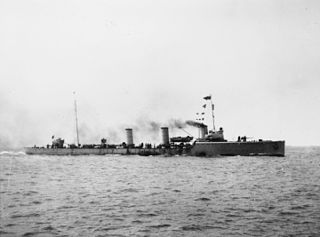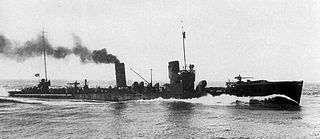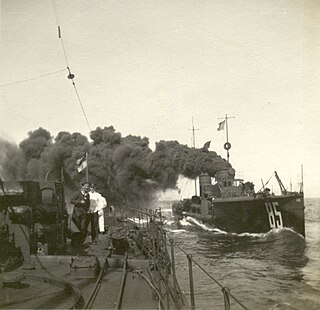
The German V1-class torpedo boats was a class of 26 large torpedo boats in service with the Imperial German Navy, Reichsmarine, Kriegsmarine and Royal Hellenic Navy in the early 20th century.

Italian torpedo boat Premuda was a 1916 Type Large Torpedo Boat of the Imperial German Navy during World War I. Built as SMS V116 she was the first ship of her class to be launched.

The French destroyer Amiral Sénès was a 1916 Type Large Torpedo Boat of the Imperial German Navy during World War I. Built as SMS S113 she was the first ship of her class to be laid down, but the second and final ship of her class to be launched.

SMS S36 was a 1913 Type Large Torpedo Boat of the Imperial German Navy during World War I, and the 12th ship of her class. She was equipped with of three single mounted 8.8 cm SK L/45 naval guns and with six 50 cm (19.7 in) torpedo tubes, two forward and four aft; twenty-four mines could also be carried. She was launched on 17 October 1914 and commissioned on 4 January 1915. S36 took part in the Battle of the Gulf of Riga in 1915 and the Battle of Jutland in 1916. In late 1916 she served in the English Channel and took part in a number of engagements, including the Battle of Dover Strait during which a British merchant ship and a destroyer were sunk by her Half-Flotilla. She was scuttled at Scapa Flow in 1919.
SMS V46 was a 1913 Type Large Torpedo Boat of the Imperial German Navy during World War I. She was built by AG Vulcan at their Stettin shipyard, being launched on 23 December 1914 and completing in October 1915.
SMS V27 was a V25-class torpedo boat of the Imperial German Navy that served during the First World War. The ship was built by AG Vulcan at Stettin in Prussia, and was completed in September 1914. The ship was sunk at the Battle of Jutland on 31 May 1916.
SMS S50 was a V25-class torpedo boat of the Imperial German Navy. Launched in 1915, she served through the rest of the war, taking part in the Battle of Jutland and operations in the Baltic. She was scuttled at Scapa Flow in 1919, but was later raised and scrapped.
SMS V4 was a V1-class torpedo boat of the Imperial German Navy. The ship was built by AG Vulcan, completing in 1912. She served in the First World War and was sunk at the Battle of Jutland on 1 June 1916.

The G101 class was a class of four large torpedo boats that were ordered for the Argentine Navy from the German shipyard Germaniawerft in 1912. They were still building on the outbreak of the First World War in August 1914 when they were seized on behalf of the Kaiserliche Marine. All four ships completed in 1915 and serving through the rest of the war, with three ships present at the Battle of Jutland in 1916. Three ships were scuttled at Scapa Flow in 1919 and one sunk as a target by American aircraft in 1921.

SMS G196 was a S-138-class large torpedo boat of the Imperial German Navy. She was built by the Germaniawerft shipyard at Kiel between 1910 and 1911, and was launched on 25 May 1911, entering service later that year. She served throughout the First World War, taking part in the Battle of Heligoland Bight on 28 August 1914. She was renamed T196 in February 1918.

SMS V187 was a S-138-class large torpedo boat of the Imperial German Navy. She was built by the AG Vulcan shipyard at Stettin between 1910 and 1911 and launched on 11 January 1911.

SMS V190 was a S-138-class large torpedo boat of the Imperial German Navy. She was built by the AG Vulcan shipyard at Stettin between 1910 and 1911, completing on 5 August 1911.

SMS V43 was a V25-class Large Torpedo Boat of the Imperial German Navy, that served during the First World War. V43 was built by AG Vulcan at their Stettin shipyard from 1914–1915, entering service on 28 May that year. V43 took part in operations in the North Sea, the English Channel and the Baltic Sea. She survived the war, and was interned at Scapa Flow, surviving the Scuttling of the German fleet at Scapa Flow. V43 was allocated to the US Navy, and was sunk as a target on 15 July 1921.
SMS V26 was a V25-class torpedo boat of the Imperial German Navy that served during the First World War. The ship was built by AG Vulcan at Stettin in Prussia, and was completed in June 1914.

SMS G102 was a G101-class large torpedo boat operated by Imperial German Navy during the First World War. The ship was ordered for the Argentine Navy from the German shipyard Germaniawerft as the San Luis, but was still under construction at the start of the war and was seized by Germany.
SMS V28 was a V25-class torpedo boat of the Imperial German Navy that served during the First World War. The ship was built by AG Vulcan at Stettin in Prussia, and was completed in September 1914. The ship took part in the Battle of Dogger Bank, the Battle of the Gulf of Riga in 1915, and the Battle of Jutland on 31 May 1916.

SMS V6 was a V1-class torpedo boat of the Imperial German Navy. The ship was built by AG Vulcan, completing in 1913. She served in the First World War with the German High Seas Fleet, taking part in the Battle of Jutland. After the war, she served with the Weimar Republic's Reichsmarine until stricken in 1929 and was subsequently broken up.

SMS V185 was a S-138-class large torpedo boat of the Imperial German Navy. She was built by the AG Vulcan shipyard at Stettin in 1910, launching on 9 April that year.
SMS V30 was a V25-class torpedo boat of the Imperial German Navy that served during the First World War. The ship was built by AG Vulcan at Stettin in Prussia, and was completed in November 1914.
SMS S49 was a V25-class torpedo boat of the Imperial German Navy. S49 was built by Schichau-Werke, at their Elbing shipyard. She was launched on 10 April 1915 and completed in July that year.














